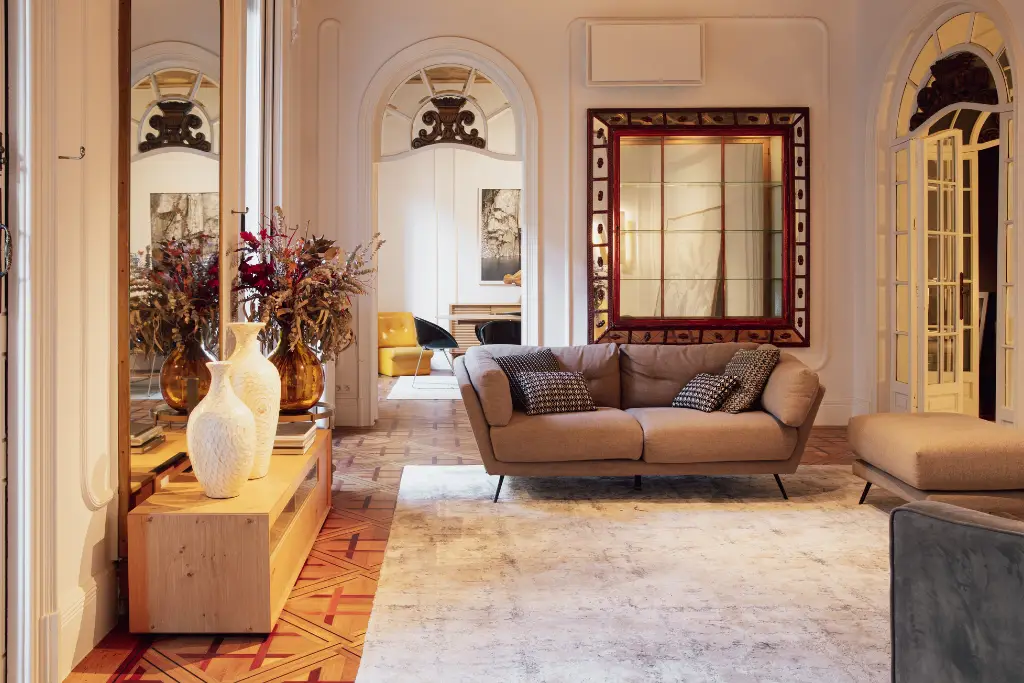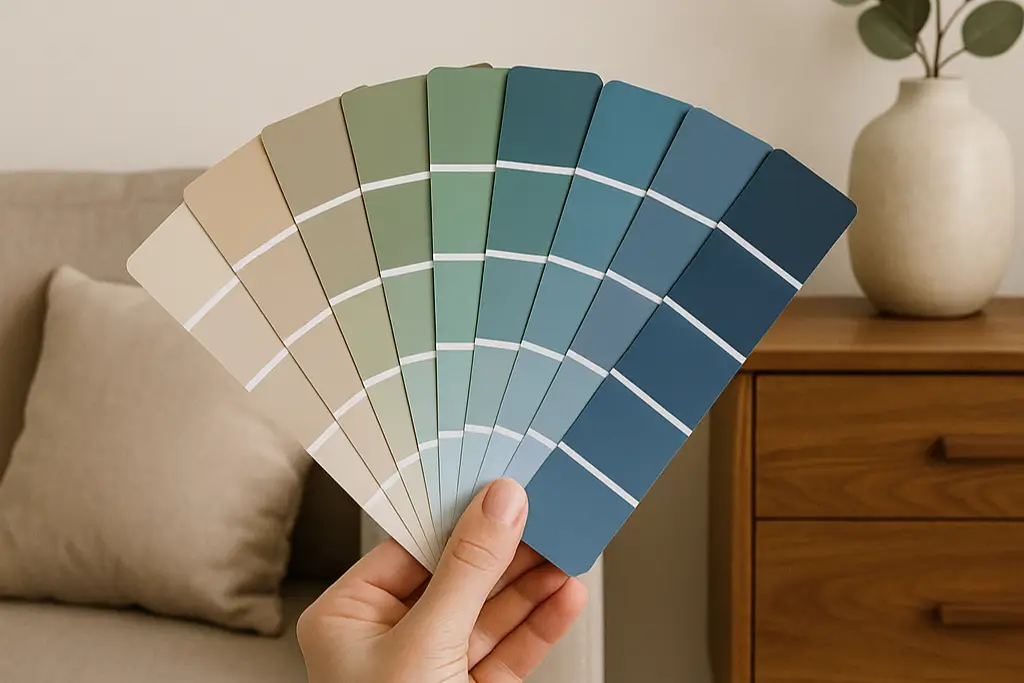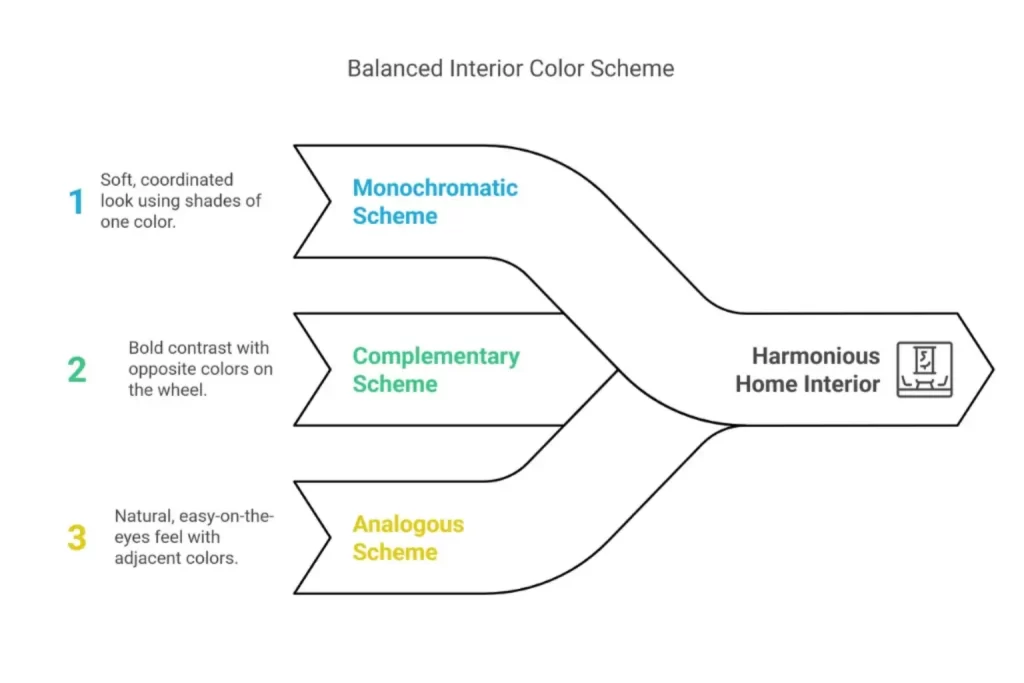
Choosing the right paint color for your home interior can feel overwhelming, but it doesn’t have to be. With so many shades and combinations available, it’s easy to get lost in color charts and paint samples. However, by following a few simple steps and understanding how colors interact with light, furniture, and space, you can make the right decision with confidence.
In this guide, you’ll learn how to select the best colour for house interiors, create pleasing house paint schemes, and match shades to your personal taste and home design

When picking a paint color, always start by thinking about the overall style of your home. The architecture, layout, and decorative details play a big role in what colors will look natural and balanced.
For example, a modern home often suits cooler tones like white, gray, or charcoal, while a more traditional space may feel warmer with creams, soft greens, or muted reds. If your home has rustic features, earthy tones like brown, tan, and olive work well to highlight natural textures.
Choosing colors that reflect your home’s personality makes the space feel more connected and thoughtfully designed.
Your furniture, curtains, flooring, and even artwork should influence your choice of interior house colors. It’s important to look at your space as a whole rather than treating the walls separately. If your furniture has strong or bold colors, a neutral wall color like soft beige, light gray, or off-white can help balance the look. On the other hand, if your furnishings are subtle, you can bring in a deeper or richer tone on the walls without making the space feel too busy.
When planning your colors, it’s also helpful to consider the overall painting services cost, as certain color choices may require more detailed preparation or multiple coats of paint, which can affect the final price. The goal is to create a color story where everything feels in harmony, and no single element overpowers the rest.
Every color has a mood, and that mood can change how people feel in a space. This is why home inside colour choices should reflect how you want each room to function and feel.
Blue is known for its calming effect, making it ideal for bedrooms or bathrooms. Green brings freshness and a natural touch, working well in almost any room. Yellow adds warmth and cheer, which is great for kitchens or living rooms. Gray, white, and other neutrals are reliable for calm, simple spaces.
Using this knowledge, you can choose shades that support relaxation, focus, energy, or comfort, depending on what each room is used for.

The color wheel is a useful tool when deciding which shades look good together. It shows how colors relate to one another and helps you build pleasing combinations.
Colors that are opposite each other called complementary colors create bold contrast, like blue and orange. Similar colors next to each other called analogous colors, create a soft, blended look, like green, teal, and blue.
Using the color wheel can help you pick two or three shades that balance well and match the style of each room. Whether you’re keeping it subtle or going bald, this simple tool can guide you to better color results
Light affects color more than most people realize. Both natural and artificial lighting can make a big difference in how a paint color appears on your walls throughout the day.
Rooms that face north tend to get cooler, softer light, which may cause paint to look a bit darker or more muted. In contrast, south-facing rooms receive warmer sunlight that can bring out the yellow or red tones in paint.
In the evenings, your choice of lightbulbs, whether warm or cool, can also impact the final look. That’s why it’s always a good idea to test a few paint samples and observe how they look in different lighting conditions before making a final decision.

A well-planned color scheme can help create flow from one room to another. When planning house paint schemes, try using a color palette that connects different parts of your home while still allowing each room to have its own personality.
Here are a few ways to build a color scheme:
Using these approaches can make your home feel more organized and visually pleasing, especially in open layouts.
Selecting a thoughtful paint scheme can completely change the feel of your home. Depending on your goals and room layout, you can go for something cozy, modern, traditional, or bright. Below are some popular ideas for house color inside combinations:
When choosing a scheme, keep your furniture and natural light in mind to ensure everything feels balanced.
Paint chips from a store can give you a general idea, but they often don’t tell the full story. Before making a final choice, apply actual samples of paint to your walls and observe them over a few days.
It’s a good idea to place samples on different walls in the room, as light hits each surface differently. Pay attention to how the color looks in the morning, afternoon, and under artificial light in the evening.
This step helps you avoid surprises and ensures that the house color inside matches your expectations once the job is done.
If you’re unsure where to begin, neutrals are a great starting point for any interior. Soft whites, beiges, and light grays are timeless, flexible, and suitable for every room.
These shades make small spaces feel larger, provide a clean backdrop for colorful decor or art, and are less likely to go out of style. Neutrals can also be paired easily with more expressive colors if you decide to add an accent wall or update furniture later.
At the end of the day, your home should reflect who you are. Think about colors that make you feel calm, joyful, or energized. These are often linked to your personal memories, experiences, or favorite places.
If you feel relaxed by the sea, try soft blues or sandy beiges. If you love the feeling of a sunny day, gentle yellows and warm whites might suit you. Choosing what inspires you will lead to more satisfaction with your space, and your home will always feel personal and welcoming
If you love color but don’t want to paint an entire room in a bright shade, an accent wall is a great solution. Choose one wall, often behind the bed, sofa, or dining area, and paint it in a deeper or more vibrant tone.
Accent colors like navy, deep green, or burnt orange can add warmth and style without overwhelming the space. You can also create visual interest using textured finishes or wallpaper on one feature wall.
This technique allows you to explore bolder interior house colors without making a long-term commitment to an entire room.
Technology makes it easier than ever to find the best colour for house interiors. Many paint brands offer online tools where you can upload a photo of your room and try different shades virtually.
You can also use design apps or websites to create mood boards, which help you match wall colors with fabrics, flooring, and decor before making final decisions.
These tools help you visualize the outcome and reduce the risk of mistakes, especially when working with multiple rooms.
By considering all the factors that contribute to a perfect paint color selection, you’re already on the right path to creating a home that reflects your style. At HabitatLux, we offer all the services you need to bring your vision to life. From expert advice and personalized color consultations to professional painting services, our team is ready to help you choose the ideal shades for every room, ensuring your home feels welcoming, vibrant, and uniquely yours. Connect with us today and let us start transforming your space into something truly special.
Finding the perfect home inside colour is about more than just picking your favorite shade. It’s about creating a space that feels right for your lifestyle, matches your home’s design, and supports the mood you want in each room.
With the right planning, color testing, and a bit of creativity, you can build a home that’s not only beautiful but also comfortable and truly personal. Whether you’re going for classic neutrals or bold, modern shades, thoughtful color choices can completely transform your space.
Mon - Sun 08:00am - 05:00pm
Mob: 050 359 0810
Unit 13 Sheikh Zayed Road - Al Quoz 1 - Dubai